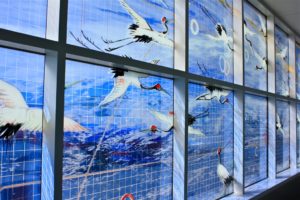Flying is a stressful activity for all of us and we all want to come out of this irksome exertion. To meet this need, at Oakland International Airport, California, United States, Kaiser Permanente has devised an innovative way to destress the jet lagged passengers. Most often airports do have this facility at their premises and many of them already have spas, massage facilities, coin-operated massage chairs, and rest zones. But the destressing procedure of the Oakland International Airport is completely different from others. It has developed a destressing station where, if you will look up, you can find painted clouds, or a wall of vines and orchids by your side, and even you can hear the sounds of songbirds. Means it provides a calmness to the flying exhaustions in the lap of nature. It’s a new way to lessen the stress.
Most often airports do have this facility at their premises and many of them already have spas, massage facilities, coin-operated massage chairs, and rest zones. But the destressing procedure of the Oakland International Airport is completely different from others. It has developed a destressing station where, if you will look up, you can find painted clouds, or a wall of vines and orchids by your side, and even you can hear the sounds of songbirds. Means it provides a calmness to the flying exhaustions in the lap of nature. It’s a new way to lessen the stress.
Late last year, Kaiser Permanente, being partnered with the airport and the terminal’s tenant, Southwest Airlines, has transformed a TSA checkpoint into a soothing oasis that is highlighted with a living green wall filled with plant species that clean indoor air naturally and provide a relaxing ambient environment.
Large white clouds suspended from the chamber ceiling greet airport patrons. Messages on panels throughout the checkpoint that encourage them to “breathe in,” “relax” and “thrive.” At the finishing point, there are “H2O to go” stations where travelers can fill their reusable bottles with filtered water for free.
Kaiser Permanente’s national leader for mental health and wellness, Don Mordecai says, “All of these elements are designed to lower the frustration that passengers often feel and it helps in improving mental health and wellness.”
The destressing station designed by Kaiser Permanente was supposed to stay only upto this month. But, considering the welcoming response of its guests, the facility has been extended to the end of 2019.
Generally airports do incorporate methods like yoga, art galleries and spas to destress their passengers when needed. And here is another one. All these methods taken together, could define the airports in future. It’s just the latest way airports are helping travelers cope with the frustrations of flying and the results are evident.

